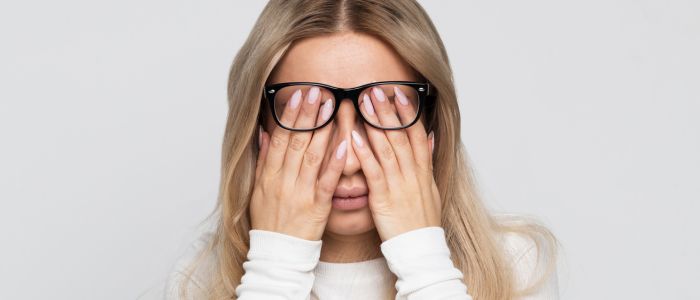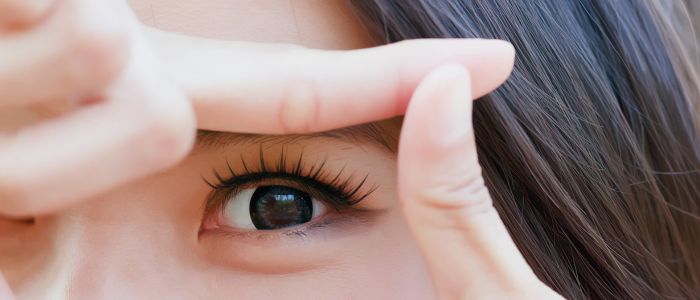
Table of Contents
- Anca Breahna’s Recommendations on How to Minimise Eyelid Swelling after Surgery
- Common Causes of Post-Operative Swelling after Eyelid Surgery
- How Much Swelling is Normal Following Blepharoplasty?
- Signs or Complications Associated with Excessive Swelling
- Recommendations to Reduce Eyelid Swelling after Blepharoplasty
- 1. Apply Cold Compresses
- 2. Keep Your Head Elevated
- 3. Avoid Strenuous Activities
- 4. Manage Your Diet
- 5. Use Eye Drops as Directed
- 6. Protect Your Eyes from Sun and Wind
- 7. Follow Your Surgeon’s Post-Operative Instructions
- 8. Attend Follow-Up Appointments
- FAQs about Eyelid Swelling after Blepharoplasty
- Further Reading about Eyelid Surgery at Cheshire Cosmetic Surgery
Anca Breahna’s Recommendations on How to Minimise Eyelid Swelling after Surgery
As a Consultant Plastic Surgeon regularly performing blepharoplasty, Anca Breahna understands that post-operative swelling can be a concern for many patients. While some degree of swelling is normal and expected after eyelid surgery, there are some steps patients can take to minimise discomfort and promote a smooth recovery. In this blog post, Anca shares her top recommendations for reducing eyelid swelling following blepharoplasty.
Common Causes of Post-Operative Swelling after Eyelid Surgery
There are many common causes of post-operative swelling after eyelid surgery, including:
- Surgical trauma: The surgical procedure itself causes tissue damage and inflammation, leading to swelling in the treated area.
- Fluid accumulation: Disruption of blood and lymphatic vessels during surgery can cause fluid to accumulate in the surrounding tissues, contributing to swelling.
- Individual healing factors: Each patient’s body responds differently to surgery, and factors such as age, overall health, and skin elasticity can influence the degree and duration of post-operative swelling.
- Allergic reactions: In rare cases, patients may experience an allergic reaction to medications, surgical materials, or post-operative products, which can exacerbate swelling.
- Excessive physical activity: Engaging in strenuous activities or exercises too soon after surgery can increase blood flow to the eye area, intensifying swelling and compromising the healing process.
- Noncompliance with post-operative instructions: Failing to follow the surgeon’s post-operative guidelines, such as proper wound care, head elevation, and cold compress application, can prolong or worsen swelling.
It’s important to note that while some degree of swelling is inevitable after eyelid surgery, following Anca’s recommendations and maintaining open communication with the surgical team can help minimise discomfort and promote a smooth recovery.
How Much Swelling is Normal Following Blepharoplasty?
After eyelid surgery, it is natural and expected to experience some degree of swelling. The amount of swelling can vary from patient to patient, depending on factors such as the extent of the surgery, individual healing processes, and adherence to post-operative guidelines.
In general, patients can expect the following swelling timeline after blepharoplasty:
- First 48-72 hours: Swelling is typically at its peak during this time, and the eyelids may appear puffy and slightly distorted. Patients may also experience some bruising and discomfort.
- First week: Swelling begins to subside gradually, but the eyelids may still appear slightly swollen and tight. Bruising may also be present but will start to fade.
- Second week: Swelling continues to diminish, and the eyelids start to look more natural. However, some residual swelling may persist, particularly in the morning or after physical activity.
- Weeks 3-6: Most of the swelling will have resolved, and the final results of the surgery become increasingly apparent. Minor swelling may still be present but is usually not noticeable to others.
- Months 2-6: Any residual swelling continues to subside, and the final results of the surgery are typically fully apparent by this time.
It’s important to remember that every patient’s healing journey is unique, and some may experience more or less swelling than others. Anca recommends that patients communicate openly with their surgical team about any concerns or questions they may have regarding post-operative swelling. By following Anca’s recommendations and attending all scheduled follow-up appointments, you can effectively manage swelling and achieve the best possible results from your blepharoplasty procedure.
Signs or Complications Associated with Excessive Swelling
There are certain warning signs and complications associated with excessive swelling after eyelid surgery. While some swelling is normal and expected, you should be aware of the following red flags that may indicate a need for prompt medical attention:
- Rapid or severe swelling: If swelling increases dramatically or seems disproportionate to the expected level of swelling based on the timeline provided by Anca, it may be a sign of complications such as bleeding or infection.
- Pain or discomfort: While some discomfort is normal after surgery, severe or worsening pain, especially if accompanied by excessive swelling, may indicate an underlying issue that requires medical intervention.
- Impaired vision: If swelling is so severe that it affects vision, causing blurry or double vision, or making it difficult to open the eyes, you should contact your surgical team immediately.
- Asymmetrical swelling: If one eye appears significantly more swollen than the other, it may be a sign of a localised complication, such as a haematoma or seroma.
- Redness, warmth, or discharge: Excessive redness, warmth to the touch, or unusual discharge from the incision sites may be signs of infection, which requires prompt treatment to prevent further complications.
- Fever: A fever, especially when combined with other warning signs, may indicate an infection or other post-operative complication that needs medical attention.
- Persistent or worsening symptoms: If swelling or other symptoms persist or worsen beyond the expected timeline, you should contact Anca for guidance and potential intervention.
Anca emphasises the importance of open communication between patients and their surgical team. If patients experience any of these warning signs or have concerns about excessive swelling, they should not hesitate to reach out to their surgeon for a prompt evaluation. By addressing potential complications early, patients can ensure a safer and smoother recovery process.
Recommendations to Reduce Eyelid Swelling after Blepharoplasty
1. Apply Cold Compresses
One of the most effective ways to reduce swelling after blepharoplasty is to apply cold compresses to the eye area. Cold therapy helps constrict blood vessels, minimising inflammation and swelling. To use cold compresses safely:
- Wrap a clean, soft cloth or gauze around a bag of frozen peas or a cold gel pack.
- Apply the compress gently to the closed eyelids for 10-15 minutes at a time.
- Repeat the process every hour during the first 24-48 hours after surgery.
Remember to avoid applying ice directly to the skin, as this can cause irritation or damage to the delicate eye area.
2. Keep Your Head Elevated
Gravity plays a role in post-operative swelling, so keeping your head elevated can help minimise fluid accumulation in the eye area. For the first few days after surgery:
- Sleep with your head propped up on several pillows or a wedge pillow.
- Avoid bending over or engaging in activities that cause your head to be lower than your heart.
- When resting, sit in a reclined position with your head elevated.
By maintaining an elevated head position, you can encourage fluid drainage and reduce overall swelling.
3. Avoid Strenuous Activities
It’s important to avoid strenuous activities and exercises for at least two weeks after blepharoplasty. Intense physical activity can increase blood flow to the eye area, exacerbating swelling and potentially compromising your recovery. Instead, focus on gentle activities such as short walks around your home or light stretching exercises as approved by your surgeon.
4. Manage Your Diet
Your diet can also play a role in reducing eyelid swelling after blepharoplasty. To promote optimal healing:
- Stay hydrated by drinking plenty of water and herbal teas.
- Avoid salty foods, as excess sodium can contribute to fluid retention and swelling.
- Eat a balanced diet rich in vitamins, minerals, and lean proteins to support tissue repair.
- Limit your intake of processed foods, sugary snacks, and alcohol, which can impede the healing process.
By making mindful dietary choices, you can support your body’s natural healing mechanisms and minimise post-operative swelling.
5. Use Eye Drops as Directed
After blepharoplasty, your eyes may feel dry or irritated due to the temporary disruption of tear production. Using preservative-free artificial tears or lubricating eye drops as directed by Anca can help:
- Alleviate dryness and discomfort
- Prevent irritation that can contribute to swelling
- Promote a more comfortable recovery
6. Protect Your Eyes from Sun and Wind
Exposure to sun and wind can irritate your healing eyelids, potentially increasing swelling and discomfort. To protect your eyes during the recovery period:
- Wear sunglasses with UV protection when outdoors, even on cloudy days.
- Avoid direct sunlight and windy conditions, especially during the first few weeks after surgery.
- If you must be outside, wear a wide-brimmed hat for added protection.
By shielding your eyes from environmental irritants, you can minimise the risk of complications and promote a smoother recovery.
7. Follow Your Surgeon’s Post-Operative Instructions
Anca provides each of her blepharoplasty patients with personalised post-operative instructions tailored to their unique needs. These instructions may include:
- Specific guidelines for wound care and hygiene
- Recommendations for pain management and comfort measures
- Instructions for safely resuming daily activities and work
It’s essential to follow these instructions closely, as they are designed to minimise complications, including excessive swelling, and ensure the best possible outcome from your blepharoplasty procedure.
8. Attend Follow-Up Appointments
Regular follow-up appointments with your surgeon are important for monitoring your progress and addressing any concerns that may arise during your recovery. These appointments allow your surgeon to:
- Assess the healing of your eyelids
- Monitor swelling and other post-operative symptoms
- Make adjustments to your treatment plan as needed
Be sure to attend all scheduled follow-up appointments and promptly report any unusual symptoms or concerns to your surgeon.
FAQs about Eyelid Swelling after Blepharoplasty

Can certain medications or supplements help reduce swelling after blepharoplasty?
While some medications and supplements may have anti-inflammatory properties, it’s crucial to consult with your surgeon before taking any new substances during your recovery. Certain medications, such as blood thinners or non-steroidal anti-inflammatory drugs (NSAIDs), may increase the risk of bleeding or other complications. Your surgeon will provide personalised guidance on which medications are safe and appropriate for your specific case.
How long should I wait before wearing makeup after eyelid surgery?
Anca generally recommends waiting at least two weeks before applying makeup to the eye area after blepharoplasty. This allows sufficient time for the incisions to heal and reduces the risk of irritation or infection. When you do begin wearing makeup again, start with clean, new products and be gentle when applying and removing them to avoid putting undue stress on your healing eyelids.
Can lymphatic massage help reduce swelling after blepharoplasty?
Lymphatic massage, when performed by a trained professional, may help stimulate fluid drainage and reduce swelling after eyelid surgery. However, it’s essential to wait until your surgeon gives you the go-ahead before pursuing any type of massage therapy. Typically, lymphatic massage is not recommended until several weeks after surgery, when the initial healing process is complete, and the incisions have closed.
Will swelling affect the final results of my blepharoplasty?
While swelling can temporarily obscure the final results of your eyelid surgery, it does not usually have a long-term impact on the outcome. As the swelling subsides, the true results of your blepharoplasty will become increasingly apparent. In some cases, minor asymmetries or irregularities may be visible during the swelling process but often resolve as healing progresses. Anca recommends waiting at least 6-8 weeks before evaluating the final results of your surgery.
Can I use ice packs instead of cold compresses to reduce swelling?
While ice packs and cold compresses both provide cold therapy, it’s generally safer to use cold compresses on the delicate eye area after blepharoplasty. Ice packs can be too cold and may cause irritation or damage to the skin if applied directly. Cold compresses, such as soft cloths or gel packs wrapped in a clean towel, provide a more gentle and controlled application of cold therapy. Always follow your surgeon’s specific instructions for using cold compresses to ensure the best possible results and minimise the risk of complications.
Medical References about Eyelid Swelling after Blepharoplasty
- Eyelid Surgery: What to Expect at Home – MyHealth Alberta: https://myhealth.alberta.ca/Health/aftercareinformation/pages/conditions.aspx?hwid=ug3834
- Can Swelling After Blepharoplasty Be Permanent?: https://www.realself.com/question/swelling-after-blepharoplasty-permanent
- Blepharoplasty – Mayo Clinic: https://www.mayoclinic.org/tests-procedures/blepharoplasty/about/pac-20385174
- Eyelid Surgery Recovery – ASPS: https://www.plasticsurgery.org/cosmetic-procedures/eyelid-surgery/recovery
- Periocular Aesthetics: Eyelid Edema – PMC: https://pmc.ncbi.nlm.nih.gov/articles/PMC1772718/
Further Reading about Eyelid Surgery at Cheshire Cosmetic Surgery
- Read more about Complete Guide to Eyelid Surgery
- Read more about Eyelid Surgery in Your 30s, 40s, 50s And 60s
- Read more about Recovery after Eyelid Surgery
- Read more about What Can Be Done to Reduce Eyelid Surgery Scars?
- Read more about When Can I Exercise after Eyelid Surgery
- Read more about Preserving Eyelid Function: Techniques for Successful Blepharoplasty








